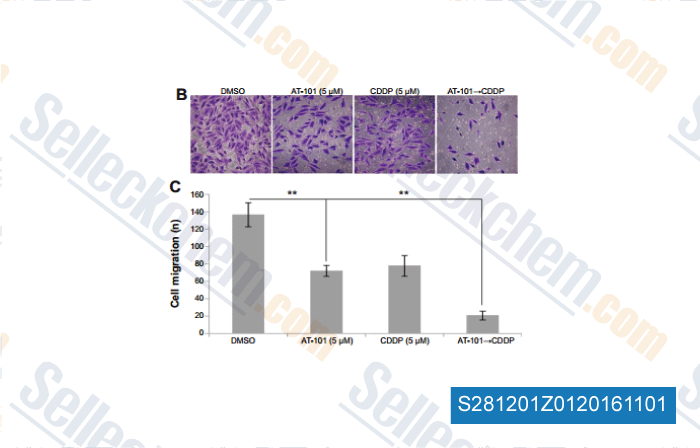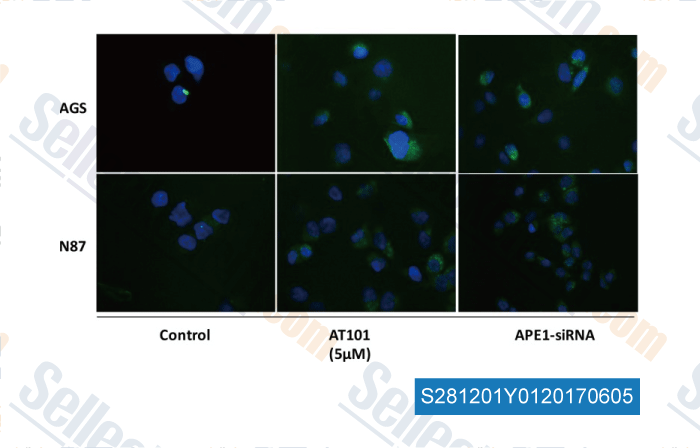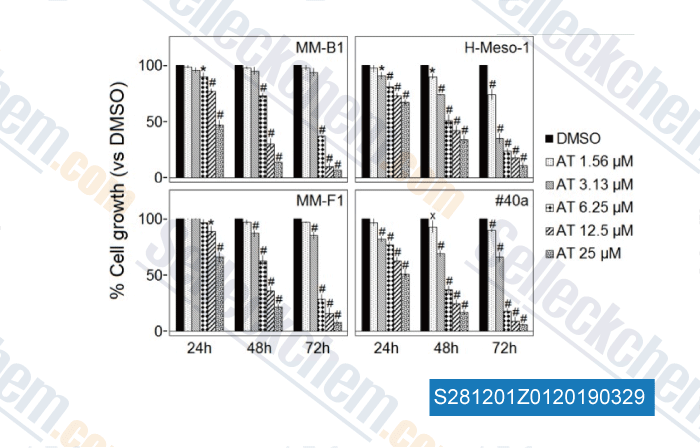|
Toll Free: (877) 796-6397 -- USA and Canada only -- |
Fax: +1-832-582-8590 Orders: +1-832-582-8158 |
Tech Support: +1-832-582-8158 Ext:3 Please provide your Order Number in the email. |
Technical Data
| Formula | C30H30O8.C2H4O2 |
||||||
| Molecular Weight | 578.61 | CAS No. | 866541-93-7 | ||||
| Solubility (25°C)* | In vitro | DMSO | 100 mg/mL (172.82 mM) | ||||
| Ethanol | 100 mg/mL (172.82 mM) | ||||||
| Water | Insoluble | ||||||
| In vivo (Add solvents to the product individually and in order) |
|
||||||
|
* <1 mg/ml means slightly soluble or insoluble. * Please note that Selleck tests the solubility of all compounds in-house, and the actual solubility may differ slightly from published values. This is normal and is due to slight batch-to-batch variations. * Room temperature shipping (Stability testing shows this product can be shipped without any cooling measures.) |
|||||||
Preparing Stock Solutions
Biological Activity
| Description | (R)-(-)-Gossypol (AT-101) acetic acid, the R-(-) enantiomer of Gossypol acetic acid, binds with Bcl-2, Bcl-xL and Mcl-1 with Ki of 0.32 μM, 0.48 μM and 0.18 μM in cell-free assays; does not inhibit BIR3 domain and BID. AT-101 simultaneously triggers apoptosis and a cytoprotective type of autophagy. Phase 2. | ||||||
|---|---|---|---|---|---|---|---|
| Targets |
|
||||||
| In vitro | AT-101 inhibits a panel of different lymphoproliferative malignancies with IC50 ranged from 1.2 μM to 7.4 μM. AT-101 (10 μM) disrupts the Δψm in a concentration- and time-dependent manner in a diffuse large B-cell and in mantle cell lymphoma lines. AT-101 (1 μM or 2 μM) combined with carfilzomib (6 nM or 10 nM) induces apoptosis in HBL-2 and Granta cell lines. [2] AT-101 (20 μM for 24 hours) results in a median 72% apoptosis and down-regulation of Mcl-1 in CLL lymphocytes in both suspension culture as well as stromal coculture. Stromal cells express undetectable levels of antiapoptotic but high levels of activated ERK and AKT proteins and has low or no apoptosis with AT-101. [3] AT-101 induces apoptosis in a time- and dose-dependent fashion, with ED50 values of 1.9 mM and 2.4 mM in Jurkat T and U937 cells, respectively. AT-101 (10 μM) combined with radiation (32 Gy) induces more apoptosis than radiation alone and exceeds the sum of the effects caused by the single agent treatments. AT-101 activates SAPK/JNK in a dose- and time-dependent manner. [4] AT-101 (10 µM) induces apoptosis through activation of caspase-9, -3, and -7 in VCaP Cells. AT-101 (10 µM) decreases Bcl-2 and Mcl-1 expression in VCaP cells. [5] AT-101 (< 20 μM) is able to inhibit the growth of multiple myeloma cells despite the stimulatory growth effects provided by stromal cells in the bone marrow milieu. AT-101 (10 μM) induces apoptosis in multiple myeloma cells via the activation of caspases 3, caspases 9 and PARP. AT-101 (10 μM) promotes apoptosis in multiple myeloma cells by disrupting the Bax/Bcl-2 ratio and the mitochondrial membrane potential. [6] | ||||||
| In vivo | AT-101 is still detectable in plasma with average concentrations of 0.49 μM for the 35 mg/kg group and 0.39 μM for the 200 mg/kg group in SCID beige mice bearing RL-DLBCL xenograft. AT-101 peak plasma concentration is observed after 30 minutes of administration of the drug in both the dose levels, with the 200 mg/kg group showing a plasma average concentration almost 4 times greater than the 35 mg/kg group (7.88 μM and 27.78 μM respectively) in SCID beige mice. AT-101 (25 mg/kg to 100 mg/kg, orally) indefinitely results in earlier onset of weight loss equivalent to more than 10% of the pretreatment weight and death in SCID beige mice. AT-101 (35 mg/kg, orally per day for 10 days) plus intraperitoneal cyclophosphamide (Cy) and intraperitoneal rituximab (R) show significantitumor volume control compared to any other treatment group. [2] AT-101 (15 mg/kg, p.o., 5 days/week) as a single agent in intact mice significantly reduces the development of VCaP tumor growth compared to untreated tumors at weeks 2 to 6. AT-101 in combination with surgical castration delays the onset of androgen-independent VCaP tumor growth compared to castration-only or AT-101-only groups in mice. [5] |
Protocol (from reference)
| Kinase Assay:[1] |
|
|---|---|
| Cell Assay:[2] |
|
| Animal Study:[2] |
|
References
Customer Product Validation

-
, , Drug Des Devel Ther, 2014, 8:2517-29.

-
Data from [Data independently produced by , , Oncotarget, 2016, 7(23):34430-41]

-
Data from [Data independently produced by , , Front Pharmacol, 2018, 9:1269]

-
Data from [Data independently produced by , , Drug Des Devel Ther, 2015, 9:2887-910]
Selleck's (R)-(-)-Gossypol (AT-101) acetic acid has been cited by 20 publications
| Follicle stimulating hormone controls granulosa cell glutamine synthesis to regulate ovulation [ Protein Cell, 2024, pwad065] | PubMed: 38167949 |
| Pharmacological Targeting of Bcl-2 Induces Caspase 3-Mediated Cleavage of HDAC6 and Regulates the Autophagy Process in Colorectal Cancer [ Int J Mol Sci, 2023, 24(7)6662] | PubMed: 37047634 |
| Exploiting ulnerabilities induced b recurrent mutations in chondrosarcoma and giant cell tumour of bone: therapeutic targeting of the altered epigenome and be [ Leiden University The Netherlands, 2023, ] | PubMed: None |
| Integrative analysis of drug response and clinical outcome in acute myeloid leukemia [ Cancer Cell, 2022, S1535-6108(22)00312-9] | PubMed: 35868306 |
| Lactate Dehydrogenase B Is Required for Pancreatic Cancer Cell Immortalization Through Activation of Telomerase Activity [ Front Oncol, 2022, 12:821620] | PubMed: 35669414 |
| Gossypol Acetic Acid Attenuates Cardiac Ischemia/Reperfusion Injury in Rats via an Antiferroptotic Mechanism [ Biomolecules, 2021, 11(11)1667] | PubMed: 34827665 |
| AT101 [(-)-Gossypol] Selectively Inhibits MCL1 and Sensitizes Carcinoma to BH3 Mimetics by Inducing and Stabilizing NOXA [ Cancers (Basel), 2020, 12(8):E2298] | PubMed: 32824203 |
| Using CETSA assay and a mathematical model to reveal dual Bcl-2/Mcl-1 inhibition and on-target mechanism for ABT-199 and S1. [ Eur J Pharm Sci, 2020, 142:105105] | PubMed: 31669390 |
| Comparison of putative BH3 mimetics AT-101, HA14-1, sabutoclax and TW-37 with ABT-737 in platelets. [ Platelets, 2020, 10.1080/09537104.2020.1724276] | PubMed: 32079453 |
| Effect of Exosomal APE1 on Sensitivity of NSCLC A549 Cells to Cisplatin [ Cancer Research on Prevention and Treatment, 2020, (7): 492-497] | PubMed: None |
RETURN POLICY
Selleck Chemical’s Unconditional Return Policy ensures a smooth online shopping experience for our customers. If you are in any way unsatisfied with your purchase, you may return any item(s) within 7 days of receiving it. In the event of product quality issues, either protocol related or product related problems, you may return any item(s) within 365 days from the original purchase date. Please follow the instructions below when returning products.
SHIPPING AND STORAGE
Selleck products are transported at room temperature. If you receive the product at room temperature, please rest assured, the Selleck Quality Inspection Department has conducted experiments to verify that the normal temperature placement of one month will not affect the biological activity of powder products. After collecting, please store the product according to the requirements described in the datasheet. Most Selleck products are stable under the recommended conditions.
NOT FOR HUMAN, VETERINARY DIAGNOSTIC OR THERAPEUTIC USE.
